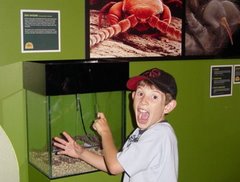This post from Chris Larry: "Thought you might find interesting the work we are doing at American History Workshop with our Telling Lives story capture technology. This technology allows audiences to answer question to a video camera that is than collected as a response database." I think that this is a very innovative approach to seeking audience feedback. Are there any others out there?
Chris: do you see this as a sustainable way to continue capturing feedback? How has the organisation used the information in their future development of programs?
Saturday, May 05, 2007
Subscribe to:
Post Comments (Atom)



5 comments:
Lynda,
Thanks for responding. Some background. American History Workshop is a exhibit design firm based in Brooklyn, NY. They developed the Telling Lives story video capture booth. They launched the technology collecting stories about New Yorkers school experiences. When their Slavery in NY exhibits went up at the New York Historical Society they included the video booths. Both the exhibits and the story capture booths were extremely popular.
This is where I entered the picture. My adviser at the Bank Street College of Education (Museum ED dept.) was contacted by Richard Rabinowitz from AHW for a graduate student who would be interested in working with the collected videos and she suggested me.
This how now become my independent study topic. The mountain of responses (over 100 GBs of data/over 3000 respondents) was overwhelming. I was then hired to make compilation videos and make highlight reels that would run in the exhibits near the booths. Richard and I also contributed a chapter in an upcoming book about audience voices to be published early summer.
This blog was started as a way to highlight the technology, engaging responses and hopefully expand the conversation of museums and social web technologies.
OK, sorry for that long winded summary. I do think this is a sustainable model and it is now been used in 3 exhibits collecting a staggering amount of responses. In addition AHW is looking to market the technology to other museums and has some interest. The problem is what to do with all this data? We have considered tagging/databasing it, making highlight videos or just storing it. The blog is a way to make the data live and breathe.
Unfortunately The NY Historical Society has very little interest in this data. That is an enormous mistake. All departments in the/a museum would find immense amount of useful information. Luckily American History Workshop values this highly. I know that this has affected Richard Rabinowitz profoundly and we are deep in conversations about how to proceed. He will be doing a seminar at the American Association of Museums conference later this month about this work.
I would love to discuss further with you. Let's continue to talk via comments or email. My day job is Supervisor of Distance Learning at the NY Hall of Science.
Thanks Chris for this information. Interesting points about the organisation uptake of the data. One of the continual problems I have is an overload of data/information and how best to present what is a really rich source of visitor voices to staff. I've chosen to use the digital storytelling method to compile my data - interpreting visitors' stories about their expectations and outcomes from their museum experiences, while also creating a product that is sent back to them. I have talked a little bit about that project here and the background to the whole New Literacies, New Audiences project is on that blog also. I'd be happy to send you the stories so you can see for yourself the type of product I'm producing here.
Was your Bank Street advisor Lesley Bedford by any chance?
Lynda,
My Bank Street adviser was Nina Jensen. I think Lesley Bedford is in the museum leadership program.
Dear Lynda,
Reading about "Innovative audience research" interest me. Is there any report from his work? This so much related to my project. As a new kid on the block, I admit that I needed every knowledge in regards to audience experience and sumamtive evaluation, especially the experience that regarding with digitally augmented exhibition like the VROOM in Melbourne Museum.
I am also looking (or this is what basically my project aim) at how designer could design a tool in assisting summative evaluation by integrating drawings as the medium to reveal or gather information about audiences' experience.
Will continue then.
Hi there Eva. I have responded to your query about summative evaluation tools on a new post. The work of Telling Lives was reported at the recent AAM conference. Here's Chris's post about that:
"Curator of the Telling Lives program Richard Rabinowitz recently presented about this project at the American Association of Museums conference. I posted the video he used, the hand out and the discussion questions on the Telling Lives Blog"
I suggest you post some questions to them there.
Post a Comment